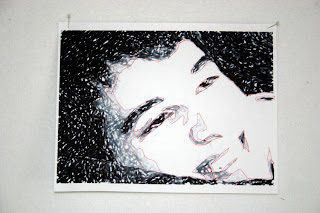
Today was BLS day - bind, label and sleeve, the finishing touches necessary for all quilts. Some people may argue that a hanging sleeve and label are optional, but if you plan to exhibit your quilt or to give it to someone, both are necessary. You need the sleeve so that your quilt isn't hung on the wall with thumbtacks and you need the label for documentary purposes. You won't remember when you made the quilt when you've finished two more afterwards and should this quilt be passed down in your family, your kinfolk will want to know when granny created this piece of folkart.
Some people enjoy this part of the process. I find it boring. I don't enjoy binding quilts. Yes, it does keep my fingers out of the chip bag in front of the television, but that's about all that I find interesting about it. It's alot like basting for me - required but grunt work.
There are several different options for binding a quilt. Some small art quilts don't even have a binding - instead, the edges are finished via a short seam length and a few trips around the edges of the quilt with decorative thread. The standard binding, as shown above, is a 1/4 inch double binding created from 2 inch strips, sewed together on the bias and folded in half. The raw edge is sewn to the front of the quilt and the folded edge is folded over to the back and affixed via a blind stitch. Another binding option that is popular in the Seattle area is to have no binding showing on the front of the quilt. The binding fabric matches the backing fabric, is sewing to the border fabric on the front, turned like a pillowcase and the opening on the back is whipstitched.
The easiest way to create a sleeve is to use some of the leftover fabric from the backing, cut it about an inch shorter than the width of the quilt and 9 inches in height. Fold over the edges on the two short sides and sew, then sew a seam along the long side. Turn inside out and press. When you sew your binding to the front of your quilt, include the top of your sleeve at the top of the quilt on the back. You need to whipstitch the bottom of your sleeve or the sleeve will show when the quilt is hung. If you tack down the sleeve flat, when your quilt is hung, a bump from the hanging pole will show. An easy way to avoid this is to fold up the bottom of the sleeve by about an inch, press to get a seam guide and stitch. When you flatten the sleeve back down, you won't see the seam and when the quilt is hung, the extra inch or so will make room for the hanging pole.
The label. The hardest part about labeling the quilt for me is coming up with a name for the quilt. Remember, it's not art unless it has a name and a price, so I always name my quilts in hopes that some day someone might buy it. You would think that it would be easy for someone who used to write for a living to come up with a pithy name, but all creativity drains from my body whenever I have to come up with titles. The quilt at the top of the page is named "Black, White and Red All Over." Yeah, kind of hokey and done to death, but I warned you.
On your label, be sure to include the name of the quilt, the year it was created and your full name. Some quilt shows require full contact information on labels. I create a secondary label that contains all of the information and put it over my label whenever I send a quilt to a show because I don't want my full contact information on all of my quilts.
I create my labels on my computer - it makes for a clearer and cleaner label. Many times I do a big batch of labels for as-yet-unlabeled-completed quilts and soon-to-be-finished quilts. I also have a sheet of 'blanks' with the year and my name. For those labels, I write in the name of the quilt with a black Pigma pen (I iron freezer paper to the back of the label so that the fabric doesn't shift as I write.). I then heat set the ink with a dry iron so that I don't smudge the label while I'm stitching it to the back of the quilt.
That's it. The quilt is done.
Or is it?
I'm still thinking that some red hot-fix crystals would be a neat addition.


















































